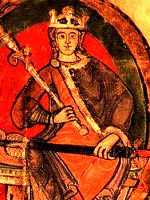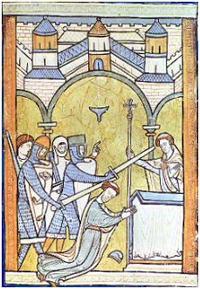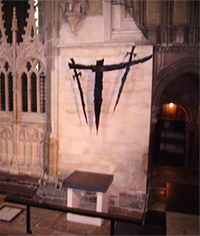King Henry II - Part 2
The style of Henry II's kingship would best be described as informal and approachable and this is reflected by the simple riding attire that he liked to wear. However, Henry's attitude to his ancestral heritage was a different matter as he set about the task of reinstating the laws and customs which prevailed during the reign of his grandfather Henry I with  much verve and vigour. Henry acted speedily and decisively to quell opposition among the barons and other overconfident Anglo Norman magnates and he destroyed a number of castles which had been used as bases for their tyrannical local rule. He also introduced a series of legal reforms creating the foundation of the English common law which has endured for centuries. He replaced the existing local courts which the barons presided over establishing Royal Courts with the Kings officials travelling extensively to bring impartial justice to all parts of the realm. Trial by a 12 man jury was introduced in 1166. Henry negotiated the return of Northumbria and Cumbria with the young Malcolm IV of Scotland (Right) and also launched a campaign in Wales to gain the loyalty of the Welsh princes. Within four years of his accession England was secure enough to allow Henry to return to France and during his 35 year reign, he would spend more than 20 years abroad but incredibly England not only survived his long absences but flourished and expanded during that time.
much verve and vigour. Henry acted speedily and decisively to quell opposition among the barons and other overconfident Anglo Norman magnates and he destroyed a number of castles which had been used as bases for their tyrannical local rule. He also introduced a series of legal reforms creating the foundation of the English common law which has endured for centuries. He replaced the existing local courts which the barons presided over establishing Royal Courts with the Kings officials travelling extensively to bring impartial justice to all parts of the realm. Trial by a 12 man jury was introduced in 1166. Henry negotiated the return of Northumbria and Cumbria with the young Malcolm IV of Scotland (Right) and also launched a campaign in Wales to gain the loyalty of the Welsh princes. Within four years of his accession England was secure enough to allow Henry to return to France and during his 35 year reign, he would spend more than 20 years abroad but incredibly England not only survived his long absences but flourished and expanded during that time.
Henry and Thomas Becket
 In 1155, Henry appointed Thomas Becket Chancellor and in June 1162 Becket was made Archbishop of Canterbury. At this time the two had been close allies during the first years of Henry's reign. However in 1164, Beckett rejected the Constitutions of Clarendon which attempted to establish royal authority over churchman and stop clerics from appealing to the Pope in Rome on legal matters and at this point Henry and Becket quarrelled and fell out. Becket's championing of the independence of the church had driven a wedge between himself and the King! Although at first Becket had run away to a Cistercian monastery in France and Henry had confiscated his
In 1155, Henry appointed Thomas Becket Chancellor and in June 1162 Becket was made Archbishop of Canterbury. At this time the two had been close allies during the first years of Henry's reign. However in 1164, Beckett rejected the Constitutions of Clarendon which attempted to establish royal authority over churchman and stop clerics from appealing to the Pope in Rome on legal matters and at this point Henry and Becket quarrelled and fell out. Becket's championing of the independence of the church had driven a wedge between himself and the King! Although at first Becket had run away to a Cistercian monastery in France and Henry had confiscated his  English possessions, by the year 1170 the pair had become reconciled and Becket returned to England at the King's invitation.
English possessions, by the year 1170 the pair had become reconciled and Becket returned to England at the King's invitation.
(Left: Earliest known portrayal of the murder of Thomas Becket)
Unfortunately, it didn't take long for Becket to once again act defiantly towards Henry and it is said that in a moment of exasperated rage, Henry cried out " Will no one rid me of this turbulent priest?" apparently it was this expression of anger which inadvertently led to Becket's death. Four knights led by Sir Reginald Fitzurse, murdered Thomas with their swords while he was praying in his cathedral thus violating the sanctuary. (Right: Site of Becket murder in Canterbury Cathedral)
In July 1174, Henry made a public act of penance at Becket’s tomb in Canterbury Cathedral. Pope Alexander III canonised Becket three years later and Canterbury became a centre of pilgrimage. - King Henry II Part 3 - King Henry II Part 1


